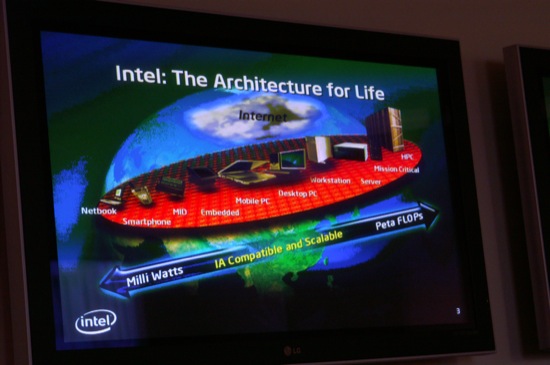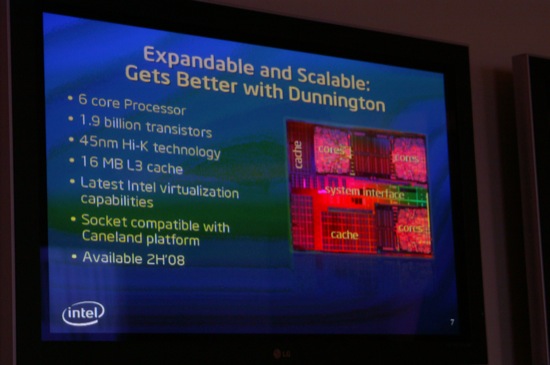Opening the Kimono: Intel Details Nehalem and Tempts with Larrabee
by Anand Lal Shimpi on March 17, 2008 5:00 PM EST- Posted in
- CPUs
Prior to its Intel Developer Forum, Intel is revealing a bit more detail on some new products coming down the pipeline - including Nehalem and Larrabee.
IDF is going to be all about scaling Intel Architecture from milli watts all the way up to Peta FLOPs. This is clearly a reference to the Intel Atom on the milli watts side and new high end quad-core Itanium and Larrabee products on the Peta FLOPs side.
First up is Intel's quad-core Itanium product, codenamed Tukwila:
Tukwila is Intel's first chip with a full 2 billion transistors and should be shipping by the end of this year, with full systems available next year. Tukwila, like Nehalem, will support Intel's QuickPath Interconnect (QPI), a point-to-point interconnect similar to AMD's Hyper Transport. Also like Nehalem, Tukwila will feature an integrated memory controller - two in this case.
Next up was the Intel Dunnington processor, a 45nm 6-core Xeon part based on Penryn cores:
With 6 cores (3 dual-core pairs on a single die) and a massive 16MB shared L3 cache, Dunnington is close to Tukwila in transistor count, weighing in at a whopping 1.9 billion transistors. Dunnington is the first shipping product to come out of Intel's India Design Team based out of Bangalore, India.
Architecturally there's not much difference between Dunnington and current Penryn based Xeon parts, you simply get more cores and a very large L3 cache shared by all of the cores. Designing such a beast isn't an insignificant effort, but it's made easier because when Intel designs a core it designs everything up to but not including the L2 cache. The L2 and everything external to it is referred to as the "uncore" and is made somewhat modular, although not quite to the same degree as Nehalem.
Dunnington is the first step in Intel implementing a very Phenom-like cache architecture with its future Core products, culminating in Nehalem.













53 Comments
View All Comments
haplo602 - Tuesday, March 18, 2008 - link
I wonder what the real world usage will be. I mean first you need to get Microsoft to code a new version of Windows to eat all that horse power. Then you are back at the begining... You have more cores but Windows is using most of them again (or not using all of them in case of old version).Anyway I don't see any significant benefits of these CPUs except highend server and workstation load.
Consumer will drift more into the console or memory/specialised processing unit (GPU, sound processors ...) markets ...
oldhoss - Tuesday, March 18, 2008 - link
The screwdriver is actually fuel for the IFRPS (Intel Fusion Reactor power supply), rated @ 1.21 Jigawatts! ;-Pbrshoemak - Monday, March 17, 2008 - link
I assume I'm not the only one who notices the glass of OJ on the 4 core Nehalem system? Kinda odd as I doubt they carry a lot of spares around.ryback - Tuesday, March 18, 2008 - link
It's not OJ. It's a screwdriver.tmouse - Tuesday, March 18, 2008 - link
Its part of the new processor cooling system. Also Intel's additional strategy Tick, Tock, Crock : enough alcohol = even BETTER coverage by the press ;)7Enigma - Tuesday, March 18, 2008 - link
HAHAHAHA! Very nice.Imaginer - Monday, March 17, 2008 - link
With intel doing things that way, I would expect the PC platform to finally have a standard instruction set for graphics processing similar to general purpose computing with the x86 standard. Would that mean that it would be ALOT EAISER for game developers to produce for the PC akin the way they are doing right now specializing for a particular console?I like that idea very much. Hopefully AMD/ATi and Nvidia would eventually be in on the standard as well.
Griswold - Tuesday, March 18, 2008 - link
I too think you got it all wrong on that one. See the other comment.kaddar - Monday, March 17, 2008 - link
No, because in general game development isn't done on instruction sets or assembly, it's done in programming languages utilizing API's. Specifically, DirectX or OpenGL. The architecture is abstracted away, and rightly so.Nihility - Monday, March 17, 2008 - link
Sounds pretty exciting. The huge cache on the Penryn procs does a pretty good job of negating the side effects of the slower memory interconnect so I'd be surprised if we see huge gains from Nehalem just because of the memory part as it wasn't that big of a bottleneck. Probably see more benefits on the server side. However, 8 cores is definitely a treat.